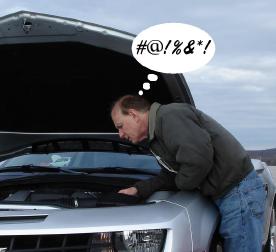
Home, Auto Repair Library, Auto Parts, Accessories, Tools, Manuals & Books, Car BLOG, Links
 .
.

 .
.
 1. Take Your Car Back To The Dealer for Free Repairs If It Is Still Under Warranty.
1. Take Your Car Back To The Dealer for Free Repairs If It Is Still Under Warranty.
All new vehicles come with a three year or 36,000 mile (which ever comes first from date of manufacture) bumper-to-bumper warranty that covers most almost everything (except "wear" items like brake pads). But some new cars have much longer warranties. For warranty coverage information on your vehicle, Click Here. Many late model vehicles also have extended powertrain warranties that may go 5 years to 10 years or 100,000 miles, or even lifetime! So check your warranty coverage to see if you may be entitled to free repairs at your dealership.
 2. Take Your Car To An Independent Repair Shop When It Is Out Of Warranty.
2. Take Your Car To An Independent Repair Shop When It Is Out Of Warranty.
Many dealers provide great service, but they are also expensive. The average labor rate is typically around $90 to $100 ore more per hour, and the price for original equipment replacement parts is usually much higher than comparable aftermarket replacement parts. Independent repair shops can often do the same repairs for less labor and parts expense. Click Here for a list of independent repair shop resources. But make sure the shop has qualified technicians and that they are using up-to-date scan tool software and other service equipment.
You can also specify if you want OEM replacement parts or aftermarket parts (new or remanufactured). Remanufactured parts can usually save you even more money, provided they are from a quality supplier and are backed by a one year or longer warranty. for more information about aftermarket remanufactured and rebuilt parts, Click Here.
 3. Fix It Yourself - If You Can
3. Fix It Yourself - If You Can
Many maintenance and auto repair jobs are still simple enough that you can do them yourself. This includes changing spark plugs, filters, belts, hoses, brake pads, sensors and many other parts. Some of these job may require special tools, and in every case accurate diagnose of a problem should always be made before any parts are replaced. Guessing at the cause of a problem can get very expensive if you don't really know what the problem is and keep replacing parts hoping this or that will fix the fault.
 4. Don't Fix It Yourself If You Can't
4. Don't Fix It Yourself If You Can't
Trying to repair a problem that is beyond your capabilities can sometimes end up costing you more than taking your car or truck to a dealer or a repair shop and paying them to diagnose and repair it for you. Yes, everybody wants to save money. But if you are not sure what you are doing, or you don't have the proper tools or know-how, you can screw up a lot of things that can be expensive to fix. It will often be cheaper to pay somebody else to fix your car for you.
 5. Get Rid of Your Car Before It Starts Costing You a Lot of Money
5. Get Rid of Your Car Before It Starts Costing You a Lot of Money
This is the most important tip of all. Though we may dearly love our old car or truck (especially if your car or truck is paid for), it is NOT going to last forever without a lot of repair expense. After so many miles and years, component parts start to wear out, break and fail. The trick to saving money on repairs is to sell or trade your old vehicle before it reaches the point where it is going to break your budget to keep it running.
Major repairs like a transmission or engine can be budget breakers. The repairs often cost more than the vehicle is worth. Changing your oil, other fluids and filters regularly can help prolong the life of the engine (and maybe the transmission, too). But even highly maintained vehicles eventually reach the point where parts start to fail. The parts most likely to need replacing include the battery, alternator, water pump, fuel pump, brake calipers and rotors, electronic modules (of which there are many on late model vehicles), various sensors (oxygen, throttle position, mass airflow, etc.), catalytic converters, exhaust pipes and mufflers. None of these components by themselves are budget busters, though some parts and modules can easily cost several hundred dollars or more apiece!. It's when you start adding up multiple repairs and repeat repairs that the cost of keeping your old car running starts to make less and less sense. For more information about how much repairs can cost, Click Here.
So when should you get rid of your wheels? My advice is to sell or trade your old car or truck before the odometer turns 80,000 to 100,000 miles (less if most of your driving is in stop-and-go city traffic, or more if most of your driving is done on the open highway). Or, get rid of it when it reaches its 8th birthday. It might still be running good and may have not cost you a dime yet in repairs, but that isn't going to last. The odds of an expensive repair hitting you sooner rather than later are going up sharply the longer you wait.
 Related Articles:
Related Articles: